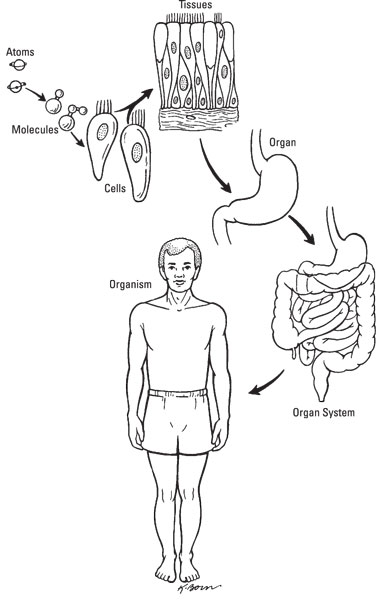Anatomy and physiology are concerned with the level of the individual body, what scientists call the organism. However, you can't merely focus on the whole and ignore the role of the parts. The life processes of the organism are built and maintained at several physical levels, which biologists call levels of organization: the cellular level, the tissue level, the organ level, the organ system level, and the organism level (shown). Illustration by Kathryn Born, MA
Levels of organization in the human body.
Level I: The cellular level
If you examine a sample of any human tissue under a microscope, you see cells, possibly millions of them. All living things are made of cells. In fact, "having a cellular level of organization" is inherent in any definition of "organism." The work of the body actually occurs in the cells; for example, your whole heart beats to push blood around your body because of what happens inside the cells that create its walls.
Level II: The tissue level
A tissue is a structure made of many cells — usually several different kinds of cells — that performs a specific function. Tissues are divided into four categories:
- Connective tissue serves to support body parts and bind them together. Tissues as different as bone and blood are classified as connective tissue.
- Epithelial tissue (epithelium) functions to line and cover organs as well as carry out absorption and secretion. The outer layer of the skin is made up of epithelial tissue.
- Muscle tissue — surprise! — is found in the muscles, which allow your body parts to move; in the walls of hollow organs (such as intestines and blood vessels) to help move their contents along; and in the heart to move blood along via the acts of contraction and relaxation.
- Nervous tissue transmits impulses and forms nerves. Brain tissue is nervous tissue.
Level III: The organ level
An organ is a group of tissues assembled to perform a specialized physiological function. For example, the stomach is an organ that has the specific physiological function of breaking down food. By definition, an organ is made up of at least two different tissue types; many organs contain tissues of all four types. Although we can name and describe all four tissue types that make up all organs, as we do in the preceding section, listing all the organs in the body wouldn't be so easy.
Level IV: The organ system level
Human anatomists and physiologists have divided the human body into organ systems, groups of organs that work together to meet a major physiological need. For example, the digestive system is one of the organ systems responsible for obtaining energy from the environment. Realize, though, that this is not a classification system for your organs. The organs that "belong" to one system can have functions integral to another system. The pancreas, for example, produces enzymes vital to the breakdown of our food (digestion), as well as hormones for the maintenance of our homeostasis (endocrine).
Level V: The organism level
The whole enchilada. The real "you." As you study organ systems, organs, tissues, and cells, you're always looking at how they support you on the organism level.

